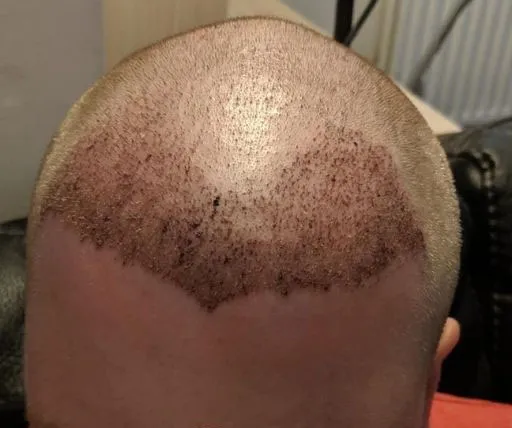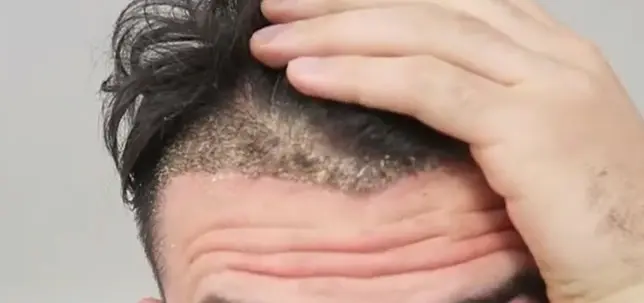Most people develop scabs after a hair transplant because the skin needs to seal and protect the tiny incisions created during the procedure. These scabs are part of normal healing and usually fall off on their own as the skin recovers.
You can expect them to last for several days before softening through proper care and gentle washing. They help protect the transplanted follicles while the tissue repairs itself. As long as you follow your surgeon’s instructions, this stage passes safely and supports healthy growth.
Key Takeaways
- Scabs after a hair transplant are a normal part of recovery, forming to protect the tiny incisions made during surgery.
- Most post hair transplant scabs fall off naturally within 7–14 days when you gently wash the scalp and follow your surgeon’s instructions.
- Avoid picking or scratching, since this can damage transplanted hair follicles and slow hair growth during the early healing process.
- Contact your hair transplant surgeon if scabs persist, become painful, or show signs of infection.
Why Scabs Form After a Hair Transplant
Scabs form because the hair transplant procedure creates tiny incisions in the skin where transplanted hair follicles are placed. These small openings trigger a healing response that produces a protective layer over each graft.
This process helps shield the recipient area from dirt, bacteria, and friction.
Your body forms scabs to close the wounds and start tissue repair. This is part of the healing and signals that your hair transplant recovery is progressing normally. Both the donor area and recipient area will show scabbing in the first days after surgery.

How Long Scabs Last After a Hair Transplant
Most patients notice scabs for 7 to 14 days. During this time, both areas of the scalp continue to heal and stabilize. In some cases, scabs persist slightly longer, especially if the skin is sensitive or if you have slower natural healing.
Hair transplant scabs after 3 weeks are less common and usually require evaluation by your hair transplant surgeon. Scabs that last beyond the expected timeline may indicate dryness, improper washing, or irritation. At Trichogenics, we monitor these signs closely so your healing stays on track.
When to Start Removing Scabs
Knowing when to remove scabs after hair transplant surgery is important for protecting the grafts. Most patients can begin softening the scabs between days 3 and 5. This period gives the transplanted hair follicles enough time to settle.
You should only remove scabs after they loosen. Trying to force them off too early may damage grafts. Your surgeon’s protocol will guide you through the safe steps, especially during the first 14 days.
Safe Steps for Removing Scabs
You can learn how to remove scabs after hair transplant safely by following a gentle, step-by-step routine. The goal is to protect the follicles while keeping the scalp clean. Warm water and light pressure help soften the scabs without disturbing the grafts.
Below is a simple method patients receive at Trichogenics:
- Gently wash the scalp with warm water using light pressure.
- Apply the approved shampoo and let it sit before rinsing.
- Use small circles with your fingertips once the grafts are secure.
- Repeat daily until the scabs fall off naturally.
This method supports the healing process and reduces crust buildup.
Washing Scabs After a Hair Transplant
Washing your hair starts the day your doctor approves it, usually within the first few days after surgery. Consistent washing helps soften the scabs and keeps the scalp clean. This step also reduces itching and allows the protective layer to shed safely.
Patients should avoid hot water, nail scratching, or rubbing too hard. Each hair transplant surgeon may provide personalized instructions based on the technique used.
At Trichogenics, we focus on gentle methods to support hair growth and protect the newly placed follicles.
What Causes Scabs After Hair Transplant Surgery
The formation of crusts after hair transplant procedures happens due to natural wound healing. Every incision produces a small amount of clotting, which dries and becomes a scab.
This is expected and helps reduce bleeding and infection risks.
Crusts after hair transplant can vary in thickness depending on your skin type and the density of grafts. Factors like hydration, washing routine, and environmental exposure also affect the scabbing pattern.
These variations are normal and part of the early recovery phase.
Can You Rub Scabs After a Hair Transplant?
You should avoid rubbing scabs during the first several days because the grafts are still stabilizing. Rubbing too early may cause the follicles to dislodge or shift. Even after the grafts anchor, pressure should remain light.
If you need to loosen scabs, use gentle washing instead of forceful rubbing. Patients should follow their clinic’s cleaning protocol to avoid harm. Trichogenics provides clear instructions so patients know exactly when light rubbing becomes safe.
Scabs in the Recipient Area vs. Donor Area
The recipient area usually develops more visible scabs because it contains many tiny incisions. Each graft produces a small crust, and these often appear evenly across the area. This pattern is normal and expected during the first week.
The donor area also forms scabs, but they tend to be smaller and less uniform. These scabs help protect the extraction points created during the surgery. Both areas should be washed gently to prevent irritation.
Key differences between both areas include:
- The recipient area heals around implanted follicles.
- The donor area heals from extraction points.
- Scabs in the donor area usually fall off faster.
- Redness may last longer in the recipient area.
Understanding these differences helps you manage your routine properly.
Normal vs. Abnormal Scabbing
Most scabs follow a predictable pattern and fall off by the second week. Normal scabbing is dry, small, and limited to the incision points. These signs show that your healing is progressing well.
Abnormal scabbing includes thick crusts, severe redness, or discharge. These issues may indicate infection or irritation. If crusts after hair transplant become painful or appear unusual, contacting your surgeon is important.
Below are signs of normal scabbing:
- Light crusts over each graft
- Mild redness around the area
- Gradual softening as you wash
- Scabs falling naturally
Signs that may need medical attention include:
- Swelling that increases over time
- Yellow or green discharge
- Persistent pain
- Large patches of thick scabs
Our team at Trichogenics evaluates these symptoms carefully to ensure safe recovery.
How to Soften the Scabs
Softening the scabs helps them shed without harming the follicles. Warm water, gentle shampoo, and light pressure are key components. The goal is to loosen them gradually without irritation.
A softening routine may include:
- Wetting the scalp with warm water for several minutes.
- Applying the approved shampoo and letting it soak.
- Rinsing slowly with low pressure.
- Repeating daily until scabs fall off.
This process avoids trauma and supports consistent hair growth.
The Healing Timeline After a Hair Transplant
Recovering from hair transplant surgery follows a predictable timeline. Scabs appear first, followed by shedding of early transplanted hairs. New growth begins gradually over several months.
The main stages include:
- Days 1–3: Formation of scabs and initial swelling.
- Days 4–7: Washing routine begins and scabs start softening.
- Days 7–14: Most scabs fall off.
- Week 3: Temporary shedding of transplanted hairs.
- Months 1–6: New growth develops.
- Months 6–12: Density improves and final results take shape.
Understanding these stages helps set realistic expectations.
@trichogenics Hair transplant before and after 🤩 #hairloss #trichogenics #hairtransplant #hairtransplantturkey #finasteride #minoxidil #malepatternbaldness #balding #dutasteride #hairlossremedy #minoxidil
♬ original sound - Trichogenics
Why Some Scabs Persist Longer
Some patients notice lingering scabs even after 14 days. Scabs persist when the scalp is dry, washing is inconsistent, or the skin heals more slowly. These factors usually resolve with proper hydration and a steady routine.
If scabs last beyond the third week, your doctor may check for irritation or buildup. At Trichogenics, we monitor each patient closely and adjust care when necessary. This ensures that healing stays on track and the transplanted hair follicles remain safe.
Risks of Improper Scab Removal
Removing scabs too early can place the grafts at risk. Newly placed follicles are delicate and require time to anchor. Forceful removal can cause graft loss or poor growth patterns.
Improper scab care may lead to infection or prolonged redness. It may also delay the healing process and affect long-term results. Following your surgeon’s protocol prevents these issues and supports healthy recovery.
Professional Care at Trichogenics
At Trichogenics, located in both Greece and Israel, we provide full post-operative guidance for every patient.
Only doctors perform our procedures, ensuring safe handling of every graft. Dr. Asi Peretz oversees the treatment plans to maintain consistent care and medical accuracy.
We do not recommend traveling to Turkey for hair transplant surgery. Turkey has limited regulations, and many clinics rely on untrained technicians.
Patients may face unsafe conditions and poor hygiene standards. Choosing a regulated medical center like Trichogenics protects your health and long-term results.
When to Contact Your Surgeon
Monitoring your recovery is important, especially if you notice unusual symptoms. Contact your surgeon if scabs become painful, spread unusually, or return after falling off. Early treatment prevents complications.
You should also reach out if you experience excessive swelling, prolonged redness, or signs of infection. Our team provides continuous support and ensures that every patient receives proper guidance.

Final Tips for Safe Healing
Managing scabs correctly helps you protect your transplant and support healthy growth. A consistent routine, gentle washing, and patience are the core elements of recovery.
Following medical instructions reduces risks and improves your long-term outcome.
Useful tips to follow:
- Avoid scratching or rubbing the scalp.
- Use only approved shampoos.
- Keep the scalp moisturized.
- Follow your washing schedule carefully.
- Attend all follow-up visits.
These steps support stable healing and long-lasting results.



